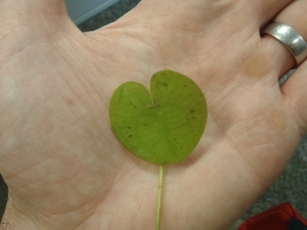|
Sept. 19, 2016
Contact: Joanne Foreman, 517-284-5814 or Sarah LeSage, 517-243-4735
Invasive species alert: European frogbit detected in West Michigan lakes
The Michigan Department of Natural Resources has confirmed the presence of European frogbit, a prohibited aquatic invasive plant, in Reeds and Fisk lakes in the city of East Grand Rapids. European frogbit was first verified in Michigan  in 1996 along the Great Lakes waterways in southeastern Michigan and has since been found in areas along Lake Huron and the eastern Upper Peninsula. The detections on Reeds and Fisk lakes represent the westernmost known locations of this invasive plant in Michigan and the Midwest. in 1996 along the Great Lakes waterways in southeastern Michigan and has since been found in areas along Lake Huron and the eastern Upper Peninsula. The detections on Reeds and Fisk lakes represent the westernmost known locations of this invasive plant in Michigan and the Midwest.
Staff from PLM Lake and Land Management Corporation initially identified the plant during a routine lake inspection and reported the finding through the Midwest Invasive Species Information Network (MISIN), triggering a notification to the DNR and the Department of Environmental Quality’s Aquatic Invasive Response Team. The team currently is assessing the risk level of the situation and working with partners in the community, including the city of East Grand Rapids, Kent Conservation District and the West Michigan Cooperative Invasive Species Management Area, to develop an action plan.
What is European frogbit?
A native of Europe and parts of Africa and Asia, European frogbit is an aquatic plant with small (half-inch to 2.5 inch), heart-shaped leaves resembling miniature water lilies. Unlike similar aquatic plants, European frogbit does not anchor its roots in the lake or stream bed but remains free-floating. Three-petaled white flowers with yellow centers appear briefly sometime between mid-July and mid-August.
Why is it a problem?
The plant quickly forms dense colonies or mats in shallow, slow-moving waters. These thick mats prevent native plant growth, make movement difficult for ducks and large fish, and cause problems for boaters, anglers and swimmers.
European frogbit is spread by plant fragments or by turions - small, quarter-inch buds that break off the plant and overwinter in lake or stream beds. Plant parts easily can be transported to new water bodies on boat motors or trailers, fishing gear and other recreational equipment.
What can be done?
“Detecting European frogbit in West Michigan is a call to action to all lake, stream and wetland users to clean, drain and dry boats and gear,” said Kevin Walters, an invasive species aquatic biologist with the DEQ. “Take the simple steps of removing all plants and debris from boats, trailers and gear and draining bilges and live wells before leaving a site. Allow boats and equipment to dry for at least five days before moving to another water body.”
Walters said that even waders, fishing nets and inner tubes can harbor invasive species and should be thoroughly dried in the sun or cleaned with a 2-percent bleach solution before being used at a different location.
What if I see European frogbit?
Anyone can help by reporting suspected European frogbit. The easiest way to report this harmful invasive plant is through the MISIN website, at www.misin.msu.edu or by downloading the MISIN app to a smartphone.
First, become familiar with identifying the plant. MISIN offers a short identification tutorial which helps distinguish between European frogbit and similar aquatic plants.
If you encounter European frogbit on the water, take some photos. These can be uploaded on the MISIN website or attached to a report via the MISIN app. Reports are directed through MISIN to DNR and DEQ aquatic biologists.
For more information on European frogbit and other invasive species, visit Michigan’s invasive species website at www.michigan.gov/invasivespecies.
/Note to editors: The accompanying photos are available below for download. Suggested captions follow.
Frogbit colony: Dense colonies of European frogbit can develop quickly in shallow, slow-moving water.
Frogbit leaf: European frogbit leaves, shown here, are similar in shape, though much smaller than those of the water lily./
The Michigan Department of Natural Resources is committed to the conservation, protection, management, use and enjoyment of the state’s natural and cultural resources for current and future generations. For more information, go to www.michigan.gov/dnr.
|

 in 1996 along the Great Lakes waterways in southeastern Michigan and has since been found in areas along Lake Huron and the eastern Upper Peninsula. The detections on Reeds and Fisk lakes represent the westernmost known locations of this invasive plant in Michigan and the Midwest.
in 1996 along the Great Lakes waterways in southeastern Michigan and has since been found in areas along Lake Huron and the eastern Upper Peninsula. The detections on Reeds and Fisk lakes represent the westernmost known locations of this invasive plant in Michigan and the Midwest. 




